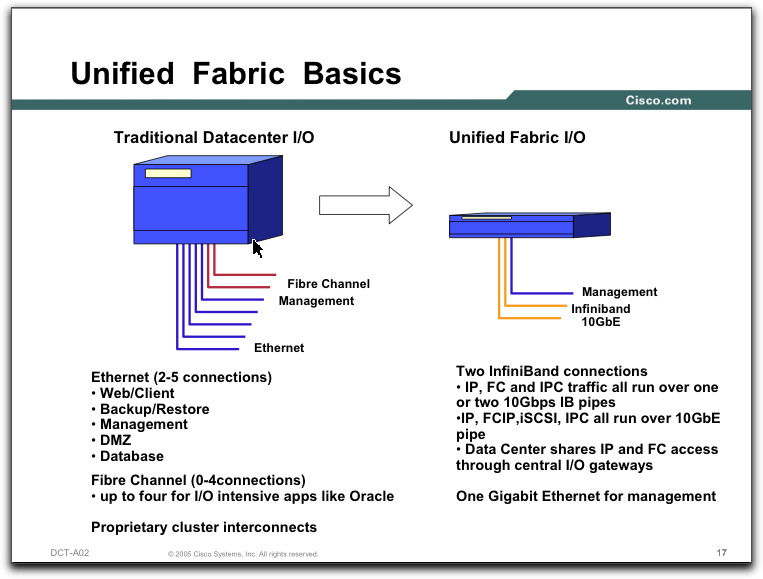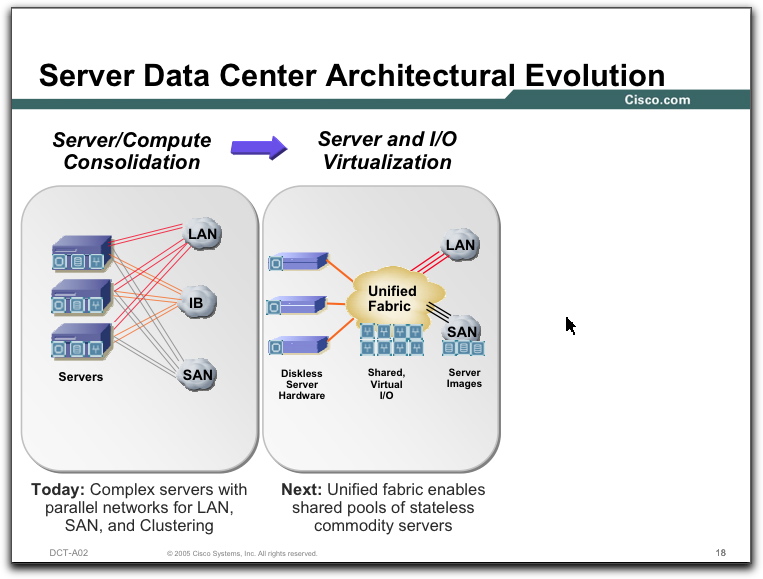Infiniband is something of a forgotten protocol these days but many of the marketing features of FCoE are directly derived from Infiniband concepts and architecture.
Paradigms of Data Center Virtualization
For example, this page is taken from the “Paradigms of Data Center Virtualization” by Cisco at Networkers 2005. If you are following Cisco UCS then it should be very familiar, perhaps surprising the the Unified Fabric idea is not new but either Infiniband or 10GB was going to be the networking fabric.
If you are reasonably new to Data Centres then you may not remember that Cisco has a moderately successful Infiniband product, and in 2005, it was the centrepiece of Cisco’s marketing strategy for a Unified Fabric for connectivity in the Data Centre. As an aggregator of connections from the server down to an Infiniband backbone it was the Unified Fabric that was going to unite the Data Centre for Grid Computing (the precursor of what is now virtualization).
Unified Fabric Server Clusters
And you can see a Case Study of this using a pure Infiniband backbone for a large scale server cluster in this slide (from the same presentation)
So what changed ?
So why didn’t Cisco continue with Infiniband ? I think it’s worth looking back and thinking how we got FCoE instead and looking for lessons to be learned. I can only speculate on what happened.
Recap on Key Infiniband Features
- InfiniBand is a high speed, low latency technology used to interconnect servers, storage and networks within the datacenter
- Standards Based – InfiniBand Trade Association http://www.infinibandta.org and has been working successfully for more than ten years.
- Scalable Interconnect speeds in multiple of 2.5Gb/s, products are currently shipping at 40Gb/s and 120Gb/s products have been announced.
- Low latency networking with delays around 20 microseconds (end-to-end) is one thousand times less than 20 milliseconds for a data centre ethernet network.
I also find it interesting that the silicon from QLogic and Mellanox has rapidly been repurposed for FCoE HBA’s. There must be strong similarities is these products for this to happen.
Ethernet is easy to sell
People will buy and use what they know. In that sense, faster ethernet or ‘newer’ ethernet is an easier decision. I assume that offering customers an easy choice, what they perceive as a simple upgrade path, is a much easier sale, than one that needs to teach customers new technologies. People tend to laziness, and this is a probable cause.
Cheap always wins
Ethernet is cheap and not very good at a lot of things but, there is a lot of it about and plenty of existing technology. And don’t forget skills, lots of people understand Ethernet and that has a price tag.
And history shows that cheap always wins.
Maybe Cisco wasn’t dominant
Cisco has a policy of being number one or two in any market. If they can’t do that, they will walk away or do something to kill that market. For example, in the early days of IPSec VPN, Cisco didn’t have a good story. They bought two or three companies before converging the code in the Cisco PIX (and later the ASA). They grew to number one by charging no license fee for their solution thus blocking all their competitors from making a profit. They same system appears to be happening today with SSL VPN which is now a small license fee for most customers.
If Cisco couldn’t dominate the Infiniband market, then perhaps Cisco spun out the Nuova Systems (the company that built FCoE and the Nexus family silicon as a startup) to give it a shot at collapsing that market.
FCoE cheaper but not better ?
If you spend some time with Infiniband, you realise that FCoE isn’t specifically a world beating technology innovation. FCoE is the VHS to Infiniband Betamax. And you can see that many of the ideas the FCoE Unified Fabric promotes are the same as those promoted in the past. In that sense, FCoE isn’t new, just a rehash of old ideas mashed onto existing technologies.
Now, I’m sure that FCoE and Cisco UCS strategy is working just fine for customers and it’s going to do well in the market. Given that Cisco has spent anything up to US$1billion buying, manufacturing and marketing the product, it’s a guaranteed success. But its worth looking back on older technologies with regret and cynically viewing these new developments to determine if they are really the best solutions for our networks.
So far, I’m not so sure. We could have had better, but FCoE will probably work just fine for a while until we need to scale and get faster than Ethernet can ever go. Maybe Ethernet will work for us in the future but Infiniband will still be there waiting for us to reuse it. Just like all the other technologies that we keep reusing.




